
|
A Return to Granite Lake by Richard L. Howey, Wyoming, USA |
Granite Lake is a reservoir which sits in Curt Gowdy State Park about 25 miles east of Laramie and the trails vary in altitude from 6,700 feet to nearly 8,000 feet. It has been 3 years since my last visit and this most recent visit may well be my last one as it was quite discouraging for several reasons. On the drive to the lake, one goes along the edge of Pole Mountain, a modest, but densely forested mountain and quite beautiful–or, at least it was. Now, about half the trees are dead and their dark, rich green color has been replaced by the repulsive brownish-orange color of dead pine needles. I have already written about the devastation caused by those wretched little beetles in an article about collecting in the higher mountains of the Snowy Range to the west of Laramie, which you can find in the Micscape archives.
As one enters the park from the highway, there is a splendid view from the ridge down to Granite Lake which sits in a valley. As you wind down the road, you encounter signs stating various prohibitions including “No Swimming” We certainly don’t want humans contaminating this water ripe with Spirogyra, cyanobacteria, such as Anabaena, rotifers, including the marvelous colonial Conochilius, crayfish, etc. Tell that to the dogs, the geese, and the ducks. Well, after all, this is a reservoir which supplies drinking water to the nearby city of Cheyenne and so there are also signs that read “Do Not Drink The Water”. At various sites around the lake, there are pipes coming up from the ground with old-fashioned metal hand pumps presumably connected to deep wells to supply fresh water. I certainly hope it’s not water from the lake.
At one point, on the north side of the road, is another lake which goes back up into a small canyon and there is a hiking trail which goes alongside it. On this particular day, the water was a rich, bright green. Back in my lab, I discovered that this was a consequence of an algal bloom of Anabaena which has spiral filaments composed of vegetative cells and heterocysts and it is the spiral species which are the mostly like to produce blooms. Here there were no ducks, geese, or dogs; only a lone fisherman who was probably wasting his time, since this species produces a toxin which in blooms occurs in sufficient quantity to be toxic to birds and other animals. As the 2 samples from this lake sat overnight, the Anabaena formed a ½ inch thick layer on the top. In the lower part of the sample, the water was quite clear and on the bottom, there was coarse sand and mini-gravel. I isolated some water and detritus from the bottom into a small dish and immediately found specimens of that splendid micro-whale, Spirostomum minus, a highly contractile ciliate which can reach a length of 2000 microns. Some researchers claim that the large species of Spirostomum have the fastest contraction rate of any known organism.

I also found a few specimens of Urocentrum turbo, that micro whirling dervish.
In addition, there were several specimens of a medium-size ciliate of an elongated ovoid shape which have a transparent “nose cone” at the anterior end.
Clearly, this heavy surface layer of Anabaena great reduces gaseous exchange and relatively quickly produces a decrease in oxygen levels. However, Spirostomum and Urocentrum are often found in water with rather low oxygen levels.
In a sample from the main lake, Spirogyra, Zygnema, and a third type of filamentous algae which I haven’t yet identified could be found. This third type has a mucilaginous sheath around the filament which stands out dramatically when a drop of India Ink is added to the slide.
On another slide sample from granite Lake, I found a small, spherical ball of Nostoc. This is a very interesting algal form in that the filaments are contained within a quite strong, rather rubbery membrane which has a light grayish-green tint.

On the other side of Laramie, up in the Snowy Range, at an altitude of about 9,000 feet, there is a shallow lake where I have found specimens of Nostoc over 2 inches in diameter.
On the same slide was a small specimen of Volvox, that extraordinary creature that is always entrancing as Wim van Egmond demonstrates so splendidly in a gallery which can be found find here:
Clearly, here in mid-August–this year at least–algal forms are thriving. The samples have numerous diatoms and desmids as well as the filamentous algal worms.
Rotifers are busily present and, in Granite Lake, one can find not only the “inch worm” Bdelloid types, but Polyarthra, the “jumping rotifer” with its feathery appendages, and the colonial Conochilius, Kellicottia longispina with its extraordinary needle-like appendages that are longer than its body, and Keratella, the one I like to describe as resembling a Klingon warship. Here is a stained specimen.

Years ago, the first time I visited Granite Lake, I thought that it was too large and too clear to have much interesting micro-life. I was completely mistaken. This afternoon, I was looking at samples which are now a week old (I did, however, mid-week add some artesian water to keep them from getting too “ripe”) and I found numerous specimens of the large hypotrich Stylonychia, bdelloid rotifers, a small unpigmented species of Stentor, some gastrotrichs, and a number of Litonotus fasciola, a couple of which were so long and slender and such a degree of contractility that, at first, I thought perhaps they were Lacrymaria olor, but closer examination revealed that they were indeed Litonotus. There is also a nice variety of pennate diatoms, a superabundance of tiny flagellates which I am sure are a food source for a number of the larger protists.
The Spirostomum which I found earlier, I had transferred into a small culture dish containing artesian water to which I had added some powdered dry lettuce and a couple of rice grains. I usually culture them in a solution of Giese salts and a wheat grain or two which I cut open with a small pair of bone cutters in order to accelerate the bacterial growth; however, on this particular afternoon, I couldn’t find my jar of wheat grains and being in a bit of a hurry, I substituted the lettuce and rice–so far, the Spirostomum seem to be doing fine. (Naturally, the next day, I found the jar of wheat grains on a shelf next to where I had been working.)
Let me return to gastrotrichs for a minute. When I was working to develop a protocol for culturing Lacrymaria olor, I kept encountering large numbers of gastrotrichs in the cultures. I had read that some researchers had had a degree of success culturing Lacrymaria using a solutions of salts which contained a bit of powdered malted milk. My friend Mike Shappell, who has since gone on to teach mathematics and computer science, was at the time my student lab assistant. To this day, we both vividly remember that some of our culture media containing malted milk had the awful reek of baby vomit. Apparently, this was quite attractive to the gastrotrichs because they reproduced in sufficient number to become a nuisance. The organism we were battling was a species of Chaetonotus.
This creature has plates or scales with lots of tiny spines. We observed that when there was contact between a Chaetonotus and a Lacrymaria, a peculiar reaction occurred in which each seemed to flinch away from the other. This seemed especially odd since there were numerous occasions when it seemed as though the gastrotrich had intentionally rammed the Lacrymaria. We made notes to investigate this behavior later, but the immediate priority was to minimize, if not eliminate the gastrotrichs from our cultures; this was done by sub-culturing. Unfortunately, we never got back to investigating the “collision problems” as we called it.
For the time being, Granite Lake continues to provide interesting micro-organisms to investigate, but how long that will continue is problematic. The park is a fee area and a day permit costs $4 whether you stay for 20 minutes or 8 hours; camping permits are more and I assume that if one wants electrical hookups that would also cost extra. These fees, however, don’t seem to discourage anyone and the State has spent a large amount of money in recent years installing boat launching docks, picnic pavilions, an archery range, additional freshwater pumps, toilet facilities, widened roads to accommodate larger vehicles, provided large sanitation trucks to collect garbage daily, and even a bait and snack shop.
These clearly are not campers with a pioneer spirit; some of them have Recreational Vehicles the size of Greyhound buses equipped with indoor toilets, water tanks for drinking water, dishwashers, showers, air-conditioning units, televisions sets, satellite dishes, GPS units, refrigerators, propane tanks for a stove and oven, computers, Xboxes, iPods, cellphones, all manner of other high-tech paraphernalia to enhance their radical encounter with Nature. These are clearly families who are prepared to tough it out in the wilderness of the Wild West.
I have an old-fashioned view that parks should be designed to enhance people’s appreciation of nature rather than being designed so that they can bring all the clutter and complexity of their home life into a wilderness context where it is empathically not appropriate. I call these “Comfort Station Parks” and they attract too many people who want a “change of scenery” in the most superficial sense. When I become Emperor of the Universe, I shall restrict some (many) parks for exclusive access to aquatic biologists (amateur and professional), students, and children who often manifest a wonderful curiosity about the working of nature (especially after you hide all their high-tech gadgets.)
I recall visiting the San Diego Zoo with my parents 60 years ago and, at the time, it was regarded as one of the best. I still recall some animals in small wire cages pacing restlessly, trapped and anxious, ostensibly to enlighten and educate us as viewers. The overall emotional impact was such that I developed a strong distaste for zoos, circuses, parades with animals, dog races, horse races, not to mention bullfights, dog fights, etc.–in short, any activity that involves the potential abuse of animals for what amounts to “entertainment’ rather than any genuine education and development of empathy. As some zoos have changed, so has my attitude (to those that have changed). Major modern zoos have made a serious and sustained effort to approximate natural habitats for their animals and have transformed themselves into research institutions to better understand the behavior and needs of their residents and a number of them have undertaken the noble task of trying to preserve and breed endangered species. Nonetheless, there are still many zoos which are grossly inadequate. Keeping animals in captivity is a very expensive and labor-intensive enterprise when done properly. Many people now deplore and are shocked by such things as the 19th Century dancing bears that were a prized entertainment or by the royal courts of Europe that collected deformed, genetically mutant human beings for the entertainment of the aristocrats. However, we need to remind ourselves that even today circus sideshows still exist which exhibit “freaks of nature” (both human and animal) and that farm factories subject animals to appalling conditions. No, I’m not a vegetarian, but I do, nonetheless, think that we humans have an ethical obligation not to mistreat animals.
What does all of this have to do with Granite Lake and Curt Gowdy State Park? Such an area should provide an escape from the high-tech hustle and bustle of the modern world and this requires some sacrifice of electronic entertainment and convenience and demands some basic education about what is wise and what is stupid in wilderness areas and even modernized parks. Every year people are seriously injured or killed by trying to feed or photograph wild animals–grizzly bears, elk, moose, bison, mountain lions–which is the result of ignorance and a lack of common sense. These are large and powerful animals that can move with surprising speed when they feel threatened and they possess formidable weapons. Also in Yellowstone, in spite of signs, people are scalded in hot pools every year.
Today Granite Lake has become a place which is no longer comfortable for me. There are too many people, dogs, large RVs, boats, docks, and camping facilities. If I trudge down to the lake with my nets and collecting bottles, I am understandably regarded with suspicion, since these people own a lot of expensive gear and a bearded old man with nets and bottles certainly looks eccentric or loony to them. I am a bit wistful about giving up this collecting site as I have, over the years, found many wonderful organisms there. Fortunately, there are a variety of other desirable sites within a reasonable distance. Nonetheless, it is hard to give up old friends.
ADDENDUM
I am attaching a mini-gallery of some of the organisms commonly found in Granite Lake.

Although this organism is a classic textbook example, it is oddly enough rather rare in nature. Fortunately, it cultures readily and so biological supply house are always able to supply it. This is one of the largest amoebae, Amoeba proteus.

This is one of the loveliest of the common desmids, Closterium and you can see the chloroplasts here clearly.


These are two common hypotrichs which are of special interest to protozoologist in significant part because they have bundles of fused cilia called cirri which are almost like miniature legs. Hypotrichs can often be seen crawling along the substrate in search of food although they can be active swimmers as well. The top one has, as you can see, an appetite for algae.

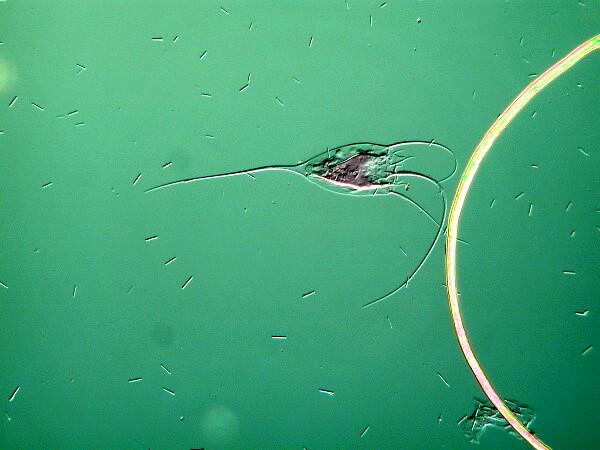
These are images of the rotifer Kellicottia longispinus which I mentioned above. It is a wonderful experience to watch these organisms swimming.
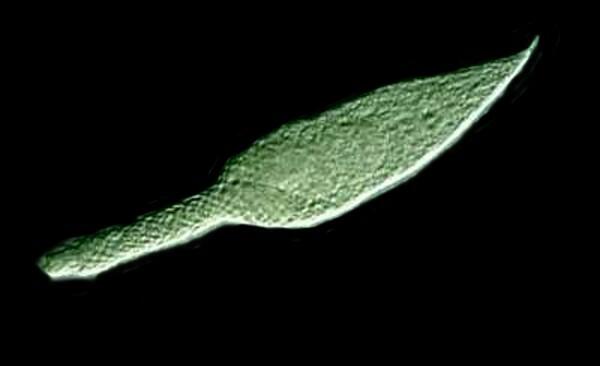
A rather unsatisfactory image of Lacrymaria olor which is in a highly contracted state here. One of this organism’s claims to fame is the extraordinary extensility of the “neck” which can achieve a length of up to 10 times its body length.
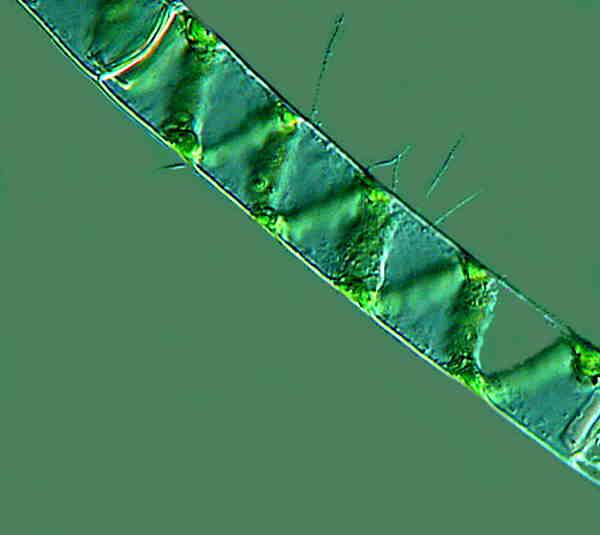
Here we have a segment of the filamentous alga Spirogyra and you can see that it is aptly named with the spiral coil of chloroplasts running through the membranous filament.
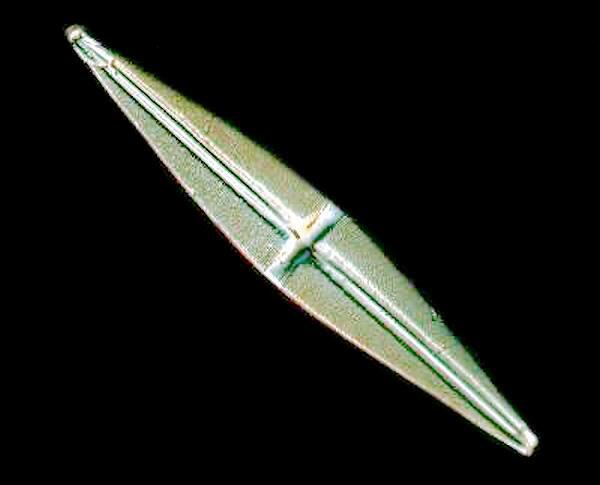
This splendid canoe-shaped diatom is Stauroneis and its “shell” is composed of silica (glass) which it extracts from the surrounding water.
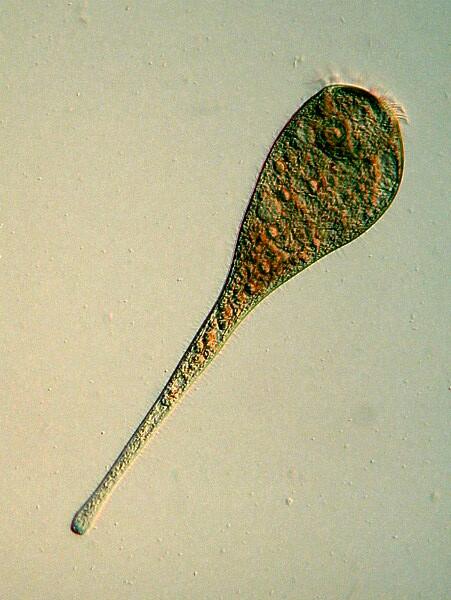
This is an image of a medium-sized, non-pigmented species of Stentor also known as the "trumpet-shaped animalcule". The large bluish-green species Stentor coeruleus is especially impressive and well worth hunting for. The apparent pigmentation in the species in the image is the result of Nomarski DIC.
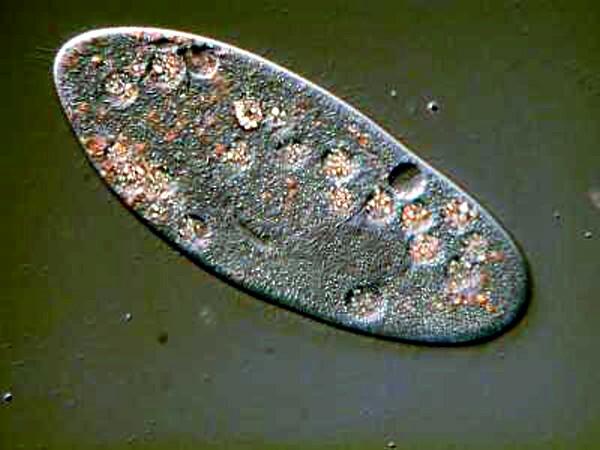
And finally, no account of common aquatic organisms would be complete without Paramecium. This image was taken using Nomarski Differential Interference Contrast to maximize contrast and if you look carefully, you will notice birefringent granules in the vacuoles and also be able to see the striations just below the surface of the pellicle which constitute the ciliary “bands”. Paramecium is an organism of astonishing complexity and is always worth studying. Fortunately, it is easy to culture and can provide many hours of pleasure and enlightenment.
All comments to the author Richard Howey are welcomed.
ADDENDUM
Our generous editor, Dave Walker, kindly mentions on the menu page of the most recent issue of Micscape that Wim van Egmond and I both received 'Image of Distinction' awards in the Nikon Small World Contest. However, he modestly neglected to mention that he also received such an award. Congratulations, Dave!
Editor's note: Visit Richard Howey's new website at http://rhowey.googlepages.com/home where he plans to share aspects of his wide interests.
Microscopy UK Front
Page
Micscape
Magazine
Article
Library
Please report any Web problems or offer general comments to the Micscape Editor .
Micscape is the on-line monthly magazine of the Microscopy UK website at Microscopy-UK .